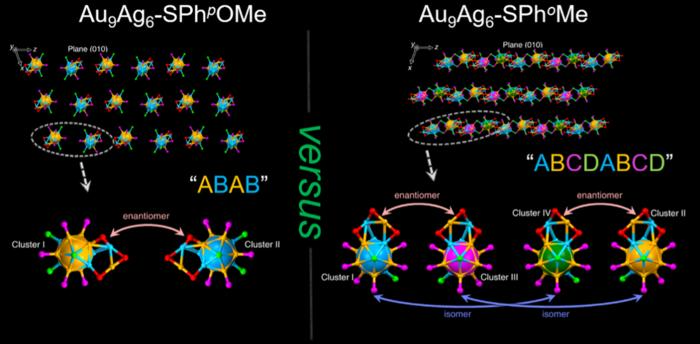Metal nanoclusters are small, crystalline structures that range up to two nm (2 x 10-9 m) in diameter and consist of a few to hundreds of metal atoms.

Two thiol ligands, SPhpOMe and SPhoMe, produce chiral, mirror-image gold-silver (Au9Ag6) nanocluster structures depending on the thiol ligand used during assembly. Clusters created using the SPhpOMe ligand form two variants that arrange in an ABAB higher-order superlattice pattern and clusters formed using the SPhoMe ligand form four variants that assemble in an ABCDABCD pattern. Image Credit: Polyoxometalates, Tsinghua University Press
Gaining a deep understanding of the precise arrangement of metal nanoclusters is essential for elucidating how various structural variations impact the properties and molecular interactions of these materials.
Recently, scientists conducted controlled syntheses of two analogous gold-silver (Au9Ag6) nanoclusters to unveil their exact atomic configurations and investigate the influence of specific thiol ligands, sulfur-containing binding molecules, on the synthesis process.
Due to their remarkably diminutive size, metal nanoclusters exhibit distinctive characteristics and hold immense potential in fields such as nanomedicine, chemical engineering, and quantum mechanics. Chemists from Anhui University conducted experiments using two distinct thiol ligands, SPhpOMe and SPhoMe, to assess their respective impacts on the synthesis of Au9Ag6 nanoclusters.
Interestingly, depending on the choice of thiol ligand, the nanoclusters formed distinct higher-order superlattice structures in which various material conformations repeated within the structure. In this context, it was the thiol ligand that played a pivotal role in generating either an ABAB pattern (in the case of the Au9Ag6-SPhoMe nanocluster) or an ABCDABCD pattern (for the Au9Ag6-SPhoMe nanocluster) within the superlattice structure, depending upon the specific thiol ligand utilized.
The study was published on September 22, 2023, in Polyoxometalates, published by Tsinghua University Press.
The highest level of knowledge in Nanoscience [is] atomic precision. [This is] why… structural science is [so important] in Nanoscience [and] other [fields like] Structural Chemistry and Structural Biology.
Xi Kang, Study Author and Researcher, Department of Chemistry and Center for Atomic Engineering of Advanced Materials, Anhui University
Kang added, “[By] studying the assembly pattern of metal nanoclusters [with] atomic precision, [we gain] the most essential knowledge [of] [molecular and supramolecular] structure evolutions… [and] structure-property correlations.”
The research team employed single-crystal X-Ray diffraction (SC-XRD) and electrospray ionization mass spectrometry (ESI-MS) to validate the precise configuration of each synthesized gold-silver nanocluster, utilizing either SPhpOMe or SPhoMe as a thiol ligand.
Notably, the choice of thiol ligand during synthesis exerted an influence on the arrangement of gold and silver atoms within the core of the nanocluster, rather than solely impacting the external nanocluster structure. The gathered data suggested a more compacted structure for the gold-silver nanocluster with the SPhoMe ligand (Au9Ag6-SPhoMe) in comparison to the one with the SPhpOMe ligand (Au9Ag6-SPhpOMe).
Furthermore, the research team observed that the variations in metal-metal bond lengths were responsible for the additional structural configurations found in the Au9Ag6-SPhoMe nanoclusters (ABCD) when contrasted with the Au9Ag6-SPhpOMe nanoclusters (AB).
The distinct molecular structures of the Au9Ag6-SPhoMe and Au9Ag6-SPhpOMe nanoclusters had a notable impact on the superlattice arrangements of the materials, as well as their optical characteristics. Initially, the research team observed that the optical absorption patterns of the two materials were quite similar, suggesting that the nanoclusters shared comparable frameworks and electron configurations.
However, in contrast, the photoluminescence intensity of the Au9Ag6-SPhoMe nanoclusters at wavelengths of 795 nm and 785 nm surpassed that of the Au9Ag6-SPhpOMe nanoclusters (at 795 nm and 758 nm) in both solution and the crystalline state.
The authors attributed these alterations in optical properties to the heightened noncovalent binding interactions present in the structure of the Au9Ag6-SPhpOMe nanoclusters, or the unique interplay between electronic coupling and lattice-origin, non-radiative decay pathways facilitated by electron-phonon interactions within the two distinct nanoclusters.
This work not only reveals two nanoclusters displaying dramatically different arrangements in their crystal units due to the strong ligand effect but also highlights that… ligand engineering should be an effective strategy for designing highly ordered cluster-based assemblies with customized structures and performances.
Xi Kang, Study Author and Researcher, Department of Chemistry and Center for Atomic Engineering of Advanced Materials, Anhui University
With this improved understanding of thiol ligand effects on nanocluster assembly, the research team looks forward to applying this knowledge to create new nanoclusters with different structures and properties.
The study of nanoclusters should head for its next step: the practical application. We hope the findings in this work… lay a foundation for the fabrication of cluster-based assembled nanomaterials with high application values. Future works will focus on promoting the ligand engineering strategy to cluster-based assembled nanomaterials and further promoting their applications in different fields, especially… optics.
Xi Kang, Study Author and Researcher, Department of Chemistry and Center for Atomic Engineering of Advanced Materials, Anhui University
The study’s other contributors include Peiyao Pan, Di Zhang, Xuejuan Zou, and Manzhou Zhu from the Department of Chemistry and Centre for Atomic Engineering of Advanced Materials, Key Laboratory of Structure and Functional Regulation of Hybrid Materials of Ministry of Education, Institutes of Physical Science and Information Technology and Anhui Province Key Laboratory of Chemistry for Inorganic/Organic Hybrid Functionalized Materials at Anhui University in Anhui, China.
This study was financially supported by the NSFC (21631001, 21871001, 22101001, and 22201001), the Ministry of Education, the University Synergy Innovation Program of Anhui Province (GXXT-2020-053), and the Scientific Research Program of Universities in Anhui Province (2022AH030009).
Journal Reference
Pan, P., et al. (2023) Ligand-correlated crystalline assembly of nanoclusters with atomic precision. Polyoxometalates.Atomic Precision Synthesis of Metal Nanoclusters .